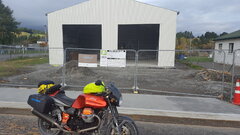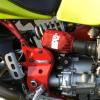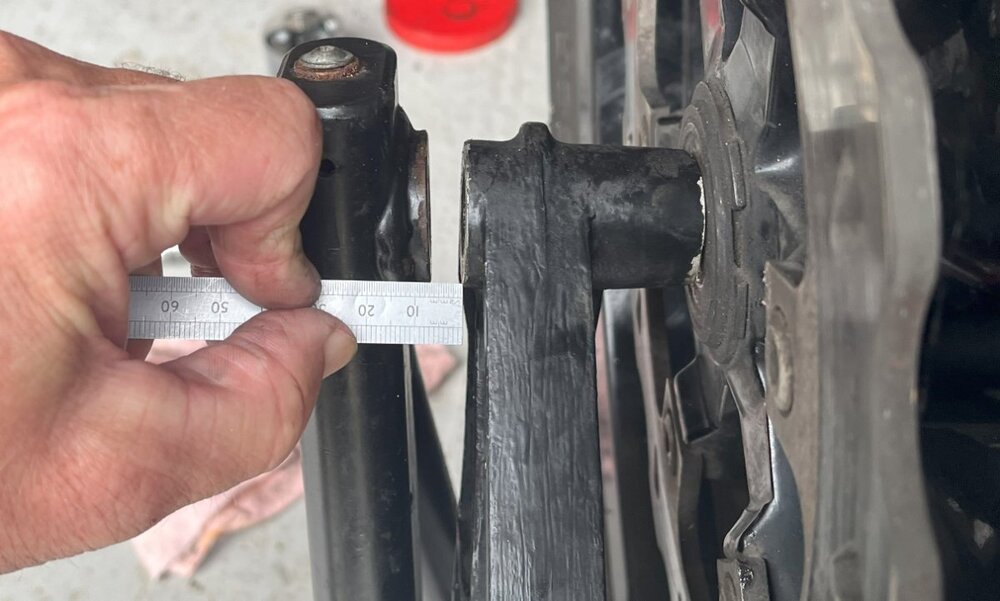-
Posts
35 -
Joined
-
Last visited
-
Days Won
1
PeterT last won the day on November 19 2024
PeterT had the most liked content!
Profile Information
-
Location
Rugby, UK
-
My bike(s)
Ghezzi-Brian V11Trofeo, Ducati V2 Panigale
PeterT's Achievements
-

Guzzi V11 Le Mans 2000...Starting issues
PeterT replied to David Sandbrook's topic in Technical Topics
If the problem is that the battery is not charging (and you can see this most easily by looking at battery voltage increasing as the engine goes above about 2000rpm and the generator can start to charge the battery) then I would agree that the un-sealed connector that the connects the wires from the voltage regulator to the wiring loom that is tied to the frame just below the left-hand side of the fuel tank, is worth looking at, cleaning and protecting it with some protective grease. On my V11 two 15A wires are used to carry the +ve and two wires the -ve, back via a 30A fuse, to the battery. The Guzzi guys may be good mechanicals but from an electrical viewpoint they really don't realise the weakness this design introduces. If any of the connections to these wires introduces some unbalanced resistance, it will cause the other wire to take the majority of the current and overheat. This is particularly likely just after starting when the charging current can be over 20A. Before you do this have a good look at the 30A fuse AND particularly its fuse holder for any signs of overheating. I burnt out three 30A fuses because of resistance between the fuse blades and the fuse holder causing a loss of charging and the engine to stall when the battery voltage fell to about 9V. I've now had to fit a sealed, in-line Maxi fuse holder that can take up to 100A fuses, though (of course) I put in a 30A fuse. This just ensures that the fuse contacts are really robust as this seemed to be the weak link in both the original and a replacement fuse holder I fitted. I have not had a problem since. -
I guess I started this thread with the aim of collecting anyone's experiences in playing about with the suspension damping. Before the weather and winter set in here in the UK (it is now dark at 16.00hrs, it is often frosty at night so salt is being spread on the roads and they often remain wet most of the day - not a good combination for a m/c!) Anyway, before this set in I did have on late afternoon ride. I reduced front rebound damping by 2-clicks and there was a slight improvement cornering around slightly bumpy "S" bends. I therefore softened the front by a further 2-clicks anti-clockwise (Ohlins say you shouldn't adjust by more than 2-clicks at a time) and the rear by 2-clicks. The result was a definite improvement without any perception that the ride was any softer or would be any worse on smooth, bends. Perhaps because I had not softened the compression damping. The bike felt more "planted" on the road and whereas I took the bends at 52mph on the original setting it gave me more confidence to take them at about 64 on the 3rd run. I do feel there is some more adjustment to go, but I must admit to being pleasantly surprised by its affect so far.
-

Rear axle build-up and dimensions of components between swing-arm
PeterT replied to PeterT's topic in Technical Topics
Thought I'd close this out by showing my (hopefully temporary) solution to fit the original steel swing-arm. Adding the widths of the components together, it was 6.7mm short of the designed 301mm between arms so I machined up a thick washer and milled a "T"-shaped brass block with 10mm reamed hole to take the brake calliper pin. -
The Moderator has very helpfully checked and given me the links to the manuals that didn't seem to work from the threads I found that gave them on this site. He says they work now. This shows the forks as being the FG43. Interestingly, I contacted Brooks of Bradford, a specialist Ohlins repair and refurbishment specialist here in the UK that refurbished and replated my front forks 4 years ago. (They have worked brilliantly ever since without any oil leaks in probably 15-20kmiles, something that was giving me a problem before in spite of changing the seals). I asked them if they had any record of what model they thought the forks were and got the answer FG313. I got the manual for this as well and there does not appear much difference between the two. The only thing I noticed was that the compression damping adjustment in both shows the 3mm Allen key at right angles to the bottom of the fork while my adjustment is much nearer 30 degrees to the axis of the fork, with the Allen key angled upwards, as shown in the MG owners manual. They said that Ohlins often made non-standard forks for particular bikes that, while based on one of their standard designs, often incorporated differences and I guess in the V11 case this meant a different casting at the bottom of the fork to incorporate the brake calliper attachment. This probably explains the difference in the angle of the compression adjustment.
-
I seem to have confirmed the mistake in the Moto Guzzi manual regarding rebound and compression damping adjustment by the simple expedient of fully closing off the top-fork adjuster and then the bottom fork adjuster. It is really obvious that the bottom fork adjuster is the one that adjusts compression damping since you get a very hard response when you suddenly push down hard on the handlebars. Fully closing the rebound damper at the top of the fork is less obvious as the rebound is just damped, whereas fully opening it there is a marked overshoot as the forks come up after being compressed. So the MG manual is wrong and this does line up with the FG43 Ohlins manual. This still leaves the question as to whether the Ohlins forks fitted are based on the FG43. Unless my search skills are defective I don't seem to find much in this excellent forum on damping adjustment. There is some on sag adjustment but not, it appears, on damping. Please correct me if I'm wrong on this. I have been looking at the Dave Moss Tuning Youtube videos and reading round on the subject and it would appear that the problem I've got in navigating a series of S-bends near my home that are a bit bumpy where my line gets thrown out, is more likely caused by having too much rebound damping. This causes the front wheel to deload after bump compression, allowing it to slide sideways and definitely giving a less precise feel and loss of confidence to the rider. I will experiment and report back once the weather has warmed up. We are in a blast of arctic air for the next few days here in the UK.
-
I have a 2005 V11 with the Ohlins suspension and I wish to play around with the damping to improve cornering on bumpy roads that I find is not as good as my other bike. Firstly, does anyone know what the Ohlins fork model was (was it the FG43?) or if not, where I can get the right Ohlins technical manual on-line? (The link for this item in the V11 forum that gives links to the manuals (fork, rear and steering damper) does not now seem to work). I do have the FG43 manual as a PDF file and when I replaced the oil, it looked to be the right one. This says that the damping at the top of the forks has a total travel of 20 clicks but when I check my actual forks it is 32; hence my worry that i've not really identified the right Ohlins manual for them. It does not say in the Moto Guzzi manual what the model the forks are, only that both compression and rebound are set 13 clicks away from fully (clockwise) closed. Also, if the forks are FG43, then the Ohlins manual says rebound is adjusted at the top of the fork and compression at the bottom but my MG owners manual says exactly the opposite. Which is right?
-

Rear axle build-up and dimensions of components between swing-arm
PeterT replied to PeterT's topic in Technical Topics
That's what I like about this membership forum; there are always people willing to provide good advice. Many thanks for all your helpful replies. -

Rear axle build-up and dimensions of components between swing-arm
PeterT replied to PeterT's topic in Technical Topics
Thanks for this. You seem to have confirmed my suspicion and solved the mystery of the missing millimetres! -
The next time a member removes the rear wheel of their V11, I would be very pleased if they could measure and post the axial widths/dimensions of the 4 main components that go in-between the arms of the swing-arm. In order of assembly, from right to left, the bevel transmission, the small spacer collar, the wheel and the cast brake calliper bracket. Is there anything else? The reason I am asking this is that I have a 6.5mm (just over 1/4") gap between the inside of the swing-arm and the brake calliper bracket once the wheel and transmission are pushed to the right. For the last 10 years the bike has run with a bespoke alloy swing-arm and when refitting the wheel, the brake calliper bracket has been a perfect push fit into the gap between the swing-arm and the left hand wheel bearing. I have now tried to fit the original steel swing-arm and found this gap that I believe is too big to simply squeeze the swing-arms by tightening up the axle bolt. Someone please tell me if I'm wrong on this and if such a gap is normal. I have measured the original steel swing-arm and the dimensions seem to be in line with the dimensional specification given in the technical manual, namely 301mm between the inside faces of the swing-arms. My suspicion is that the alloy swing-arm (that I no longer have) had a slightly smaller dimension and that the brake calliper bracket was reduced in width; hence my request for someone to measure this and, in case this is no different, the other components as well, though I really cannot see how these can have been changed from the original design specification. If the brake calliper bracket has been modified, then at least I will know that, if I bought a new replacement, that this would solve my problem. The dimensions I have measured are:- Bevel transmission gear - 90.06mm (3.54") Spacer collar - 12.4mm (0.488") Wheel (across bearings)- 141.8mm (5.58") Brake calliper bracket - 50.45mm (1.99") Total 294.7mm Dimension between swing-arms- 301mm Gap - 6.3mm
-

Share your lithium battery experience; cold environment, durability, else?
PeterT replied to p6x's topic in Technical Topics
I've been running a BC LiFePO4 battery in my V11 for the last 7 years. It is 1 size smaller than BC recommend for a V11 (mine is a BCTZ14S-FP-S 12V, 54Wh) but I needed this size to fit in the Ghezzi Brian tail. It is incredibly light. It puts out loads of cranking amps. I measured it using special resistive shunt and an oscilloscope, and the initial peak current was nearly 500A before it rapidly subsided as the engine cranked over. Yes they do seem to put out less current when cold so I agree with previous comments. But they do keep their charge remarkably better than a lead type, assuming there is little or no small leakage current to drain them. One thing to bear in mind is that their capacity is not as large (they are, after all a fraction of the weight and about half to 1/3rd of the volume). The 12V, 54Whr of the LiFePO4 battery corresponds to 4.5 Ampere-hours, while the original equipment lead battery fitted is 13Ah. This is really only required to make the lead battery big enough to reduce its internal resistance so it can give enough cranking amps. The LiFePO4 battery can do this from a much smaller size because it has a fundamentally much smaller internal resistance. Obviously, you don't need much capacity to start, so the smaller capacity is fine, but if anything does drain the battery while it is not charging (like leaving the parking lights on when parked or if your charging circuit has a fault) the battery will become flat about 3 times quicker. I have a voltmeter fitted to the dashboard so I can see exactly when it is charging as I have had overheating problems with the small 30A charging mini fuse holder but I have cured this by putting in a new, much larger, Maxi fuse-holder on a dedicated flying lead that is capable of taking 100A fuses: obviously I still only put in a 30A fuse but it has cured the tendency for the charging circuit to fail due to degradation of the fuse holder contacts. This brings me to my last point which is that when I put the bike on its intelligent charger its self diagnostic does not like the leakage current the bike takes and it says the battery is faulty. This is due to leakage current through the diodes of the alternator rectifier (I think more modern bike rectifiers have diodes with much lower leakage current), so I remove the 30A fuse to isolate it and all is well. This would seem to me to be a good precaution if you use a LiFePO4 battery if it is being laid up for any time, whether you put it on the a maintenance charger or not. In fact, for a standard V11 the rectifier is probably the only significant current drain and once this is removed, the LiFePO4 battery seems to maintain charge almost indefinitely. -
The selector spring in my 2005 manufactured V11 failed after only 21000 miles. The Piaggio dealers that I managed to limp to in 2nd gear (I think) couldn't get a replacement spring quickly so I got one from Gutzibits in the UK. So I'm not sure if this was better, worse or the same as the standard part. Since this is my one and only mechanical breakdown in what is now 45000miles of happy riding, I have followed this thread with interest. Understandably, after a further 27000 miles since the last spring failure, I am concerned that it is due to fail again, possibly when touring abroad; I'm going to the Picos in Spain at the end of next month. Can anyone help me by letting me know how I can get hold/buy of one of these superior springs? I am in the UK.
-

ANSWERED OMRON G8HE-1C7T-R-DC12 DC12V or Equivalent (CIT A11CSQ12VDC1.5R?)
PeterT replied to p6x's topic in Technical Topics
I've had my share of problems with the starter motor but I've never had any problems with my micro relays. That's not to say that the starter contactor may not draw a short-term current that could cause problems, it's just not something I've experienced (yet). However, I have experienced exactly the same symptoms; lights dim when starter button pressed and you hear the click of the starter contactor but it doesn't crank, or ties to so weakly that you know it's not going to start. You try again and sometimes it may work, sometimes not. The cause in my case (and this is the reason I thought I'd add to the wisdom already given) was that the crimped (female) blade that pushes onto the starter motor contactor, was not particularly strong/grippy and had a bit of corrosion in it. Sorting this out cured the problem. Effectively insufficient current could be drawn by the contactor coil to pull in the starter contacts strongly enough, these then added extra resistance to the starter motor circuit and the motor cranked weakly or not at all. Perhaps it was this that caused the actual starter motor contacts to arc and pit, because soon after this I had the same thing again, but this time diagnosed that it was these main contacts that take up to 500A peak and typically interrupt the 120- 150A d.c. cranking current in an inductive circuit. This in itself is something that you might expect to cause degradation over time. Anyway, having checked that it wasn't the same thing again and diagnosed that the actual main contacts were adding abnormal contact resistance, I fitted a new starter and this solved the problem. So my contribution in all this talk of getting better relays (and of course the relay could also cause a weak pull-in of the starter motor contactor relay) is to make sure you have checked these other two causes. -
I had a similar problem on my 2005 V11 but I didn't think about the possibility that the volts may be dropped across degraded contacts of the ignition switch that feeds the contacts of the starter mini-relay and through that the starter contactor coil. So I'm definitely NOT saying that any of the previous conversation and ideas are wrong. Quite the opposite. Putting a voltmeter on the input to the starter motor contactor would show whether this is the problem, especially if you know what the normal voltage drop should be. My, hopefully positive, contribution to this thread is to say that my diagnosis was that there was a problem with the starter motor contactor whose contacts seemed to add sufficient resistance to make cranking poor or to stall. It was never clear to me whether the mechanical contactor mechanism degraded and was getting partially seized so as to put less contact pressure on its starter contacts, or if it was simply that the starter contacts themselves had started to pit and degrade. All I noticed was that the starter motor was very slow (or would fail to crank) but often would start OK on the second attempt. My hypothesis was that this was either because the battery was a bit warmer and delivered a bit more current to the contactor coil or perhaps the main contactor contacts just closed with a bit less contact resistance that time. I got a new starter and the problem was solved, so, in my case at least, I feel that the problem was a degradation in the motor contactor mechanism or contacts. At 500A transient peak and 150A cranking, just the slightest extra contact resistance can be disastrous and with this d.c. current you might expect contactor deterioration over time. But the possibility that the contactor coil does not get sufficient current to pull in the main motor contacts strongly would have exactly the same effect so worth bearing both in mind before investing in a new starter.
-
I've tried a few different tyres on my V11 and carefully logged the wear rate and experience. Starting with Metzler Sportec M5 that felt a bit less grippy in the damp and wet and would feel "squemish" when traversing painted while line in the wet. They only lasted 4k miles. I then tried Metzler Sportec M7RR; the latest version at the time. They felt a bit better in the wet and the life was about the same; around 3.5 to 4,5k miles with slightly more life for the front than the rear, although I always change both at the same time to keep them in step and avoid having to spend even more time going to the tyre shop. I then tried Pirelli Rosso III's. They were even better than the Metzler in the wet and lasted a bit longer too; 5k at the rear and, potentially 6k on the front. I then tried Pirelli Rosso Corsa II's and they were a bit better still in the wet and possibly wear very slightly better as I got 5.5k out of the last pair (though this might be that I'm getting smoother or slower) and I've fitted these the last three times.









